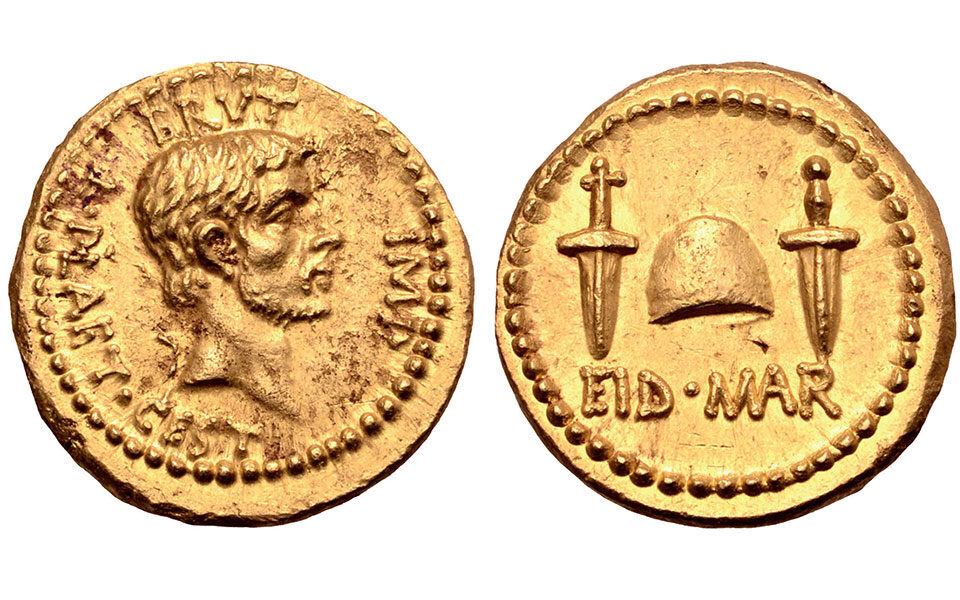A rare version of a coin commemorating the assassination of Julius Caesar on the Ides of March, 44 BC – arguably one of the most famous coins in Western history – has been returned to Greece following a special ceremony at the Greek Consulate General’s office in New York. Referred to as the “Denarius of Brutus” or “EID MAR,” it is one of only three known examples of the gold (“aureus”) variant still in existence.
The coin, which is about the size of a US nickel and weighs eight grams, was purchased by an unidentified American billionaire for US$4,188,393 at the Roma Numismatics auction in London in October 2020 – a world record for an ancient coin. Following an extensive investigation by members of the US Homeland Security Investigations (ICE) unit in New York and the Manhattan District Attorney’s Antiquities Trafficking Unit, supervised by Matthew Bogdanos, it was determined that the coin had been looted from Greece and fraudulently put up for sale using fake provenance. The undisclosed buyer subsequently handed it over to US authorities in February this year, while Richard Beale, director of the London-based auction house, has been charged with grand larceny.
“The EID MAR is an undisputed masterpiece of ancient coinage,” said Mark Salzbery, the chair of the Numismatic Guaranty Corp., who verified the coin in 2020. The exceptionally rare artifact is one of 29 Greek antiquities repatriated by US authorities this week, including the so-called “Neolithic Family Group” of figurines (5000-3500 BC) and a large bronze calyx krater, dated to 350 BC.
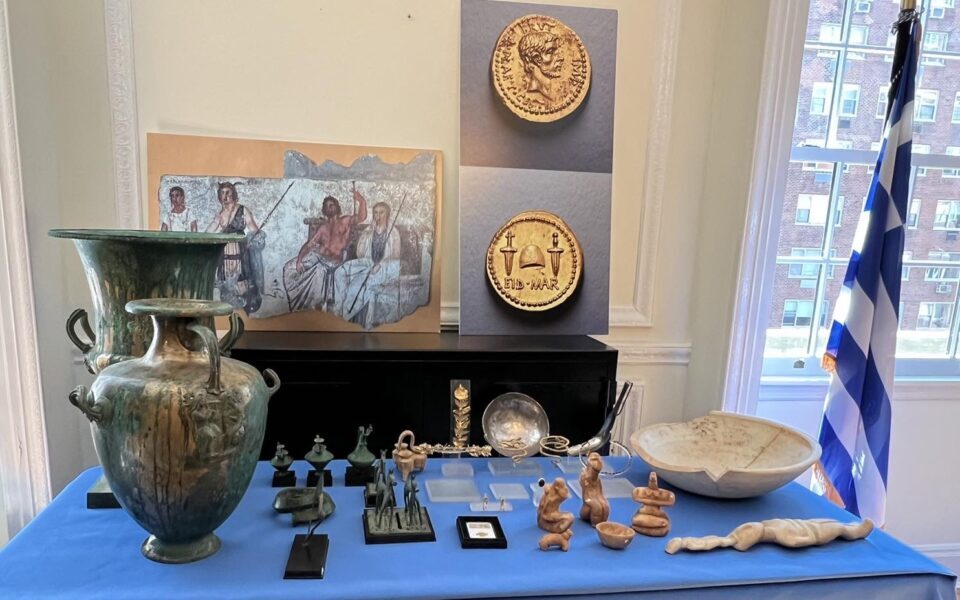
THE “EID MAR” DINARIUS
Minted in 43 or 42 BC, the obverse (the side bearing the head or principal design) of the coin features a portrait of Marcus Junius Brutus, one of Caesar’s chief assassins. Around its perimeter is the Latin text: “BRVT IMP” and “L PLAET CEST,” meaning “Brutus, Imperator” (referring to his status as a commander, not emperor), and “Lucius Plaetorius Cestianus,” the name of the moneyer (treasurer) who produced it. The inclusion of the moneyer functioned as an assay mark, guaranteeing the quality of the metal.
On the reverse, the simple yet highly effective design of a pileus (liberty cap, usually worn by freed slaves) flanked by two bloodied daggers is underlined by the date of the infamous assassination, “EID MAR” (the abbreviated form of Eidibus Martiis – the Ides of March). Interestingly, the daggers are slightly different, individually representing the two main leaders of the conspiracy against Julius Caesar: Brutus and Gaius Cassius Longinus.
Voted the greatest ancient coin of all in 2008 by a consortium of collectors and art dealers, it is the only Roman coin to mention a specific date, the 15th day of March, and the only one to commemorate an assassination. It is also one of the few coin types to be mentioned by a contemporary Roman historian, Cassius Dio (c. 155-235 AD), who provided a detailed account of the events leading up to the assassination and its aftermath in his 80-book “Historia Romana”: “Brutus stamped upon the coins which were being minted his own likeness and a cap and two daggers, indicating by this and by the inscription that he and Cassius had liberated the fatherland.” (XLVII.25)
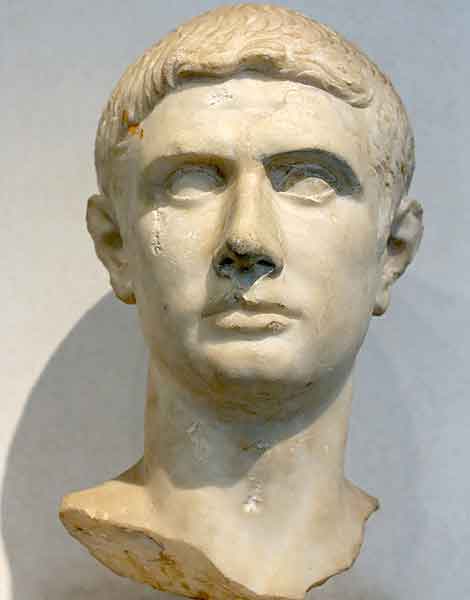
© Public domain
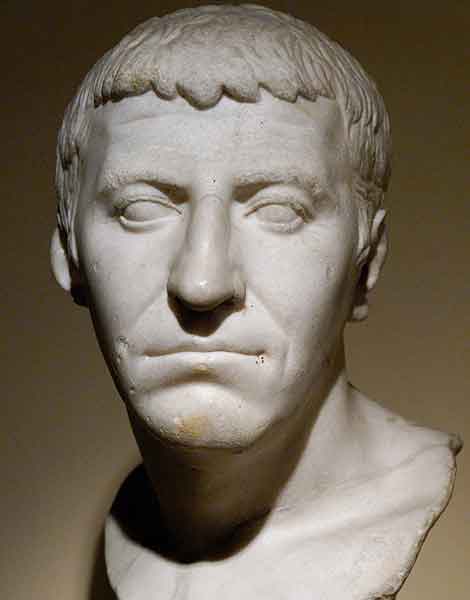
© Public domain
WHY SO RARE?
Produced in both silver and gold, about 100 examples of the more common silver version of the EID MAR denarius are known to exist. These can fetch anywhere between $200,000 and $400,000 at auction. Scholars believe they were minted by a mobile coinage workshop that accompanied the army of Brutus and Cassius in the ensuing Liberators’ civil war, fought between the conspirators and the Second Triumvirate of Mark Antony, Octavian (the future first emperor, Augustus), and Caesar’s “Master of the Horse,” Lepidus.
In order to fund the army and pay their soldiers, Brutus and Cassius minted their own coins on the march. Brutus’ stark design of the EID MAR coin was not only a political statement, it was a sober reminder to his soldiers that they were fighting for the freedom of the Roman Republic. The Liberators’ civil war came to its bloody climax in October 42 BC at the Battle of Philippi in Macedonia, where the forces of Brutus and Cassius were routed by the combined armies of Antony and Octavian.
The rarity of these coins is almost certainly due to the victorious Triumvirs declaring them illegal tender in the immediate aftermath of the civil war. Their agents would have confiscated and melted down the mintage, thus halting the further spread of propaganda and quelling any remaining support for the conspirators.
Experts who investigated the recently repatriated gold coin believe it was discovered a decade ago in an area of northern Greece where Brutus and his ally Cassius were encamped with their army. It was then trafficked out of the country and appeared on the international auction market with forged documents, sometime between 2013 and 2014.
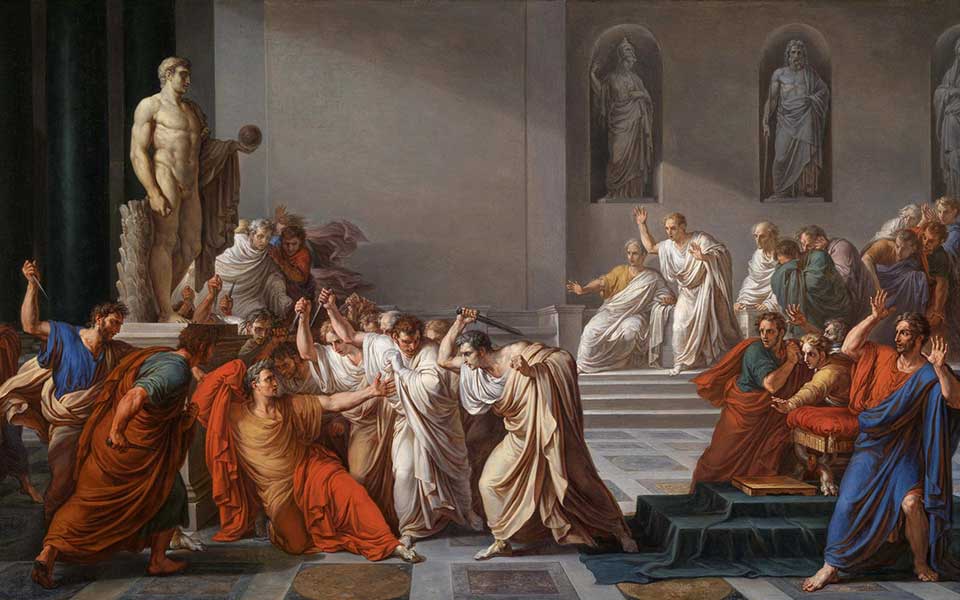
© Public domain
“Sic semper tyrannis” (Thus unto tyrants)
The EID MAR coin marks a dramatic turning point in the history of the ancient world: the end of the Roman Republic and the rise of the empire; an event that changed the course of Western history.
Brutus, Cassius, and their co-conspirators regarded the assassination of Caesar as an act of patriotism in the defense of liberty. During his ascent to power, Caesar had showed signs of megalomania, assuming the mantle of an absolute monarch and appointing himself dictator for life. He also undermined the chokehold of the Roman nobility, the Patricians, in the Senate, and was perceived as a threat to their traditional power base. In doing so, he disrespected long-established Republican ideals and standard Senatorial procedure.
While Caesar’s assassination proved unpopular among the Roman people, in Cicero’s “Philippics,” a collection of 14 speeches composed in 44 and 43 BC, the prominent Roman senator praised the actions of the conspirators as the justified killing of a tyrant, going as far as to call them “the best of men.” Proscribed as an “enemy of the state,” Cicero was subsequently hunted down and killed on Antony’s orders.
Modern historians have long debated whether the conspirators’ actions were justified, often arguing from postmodernist perspectives of power and class.

